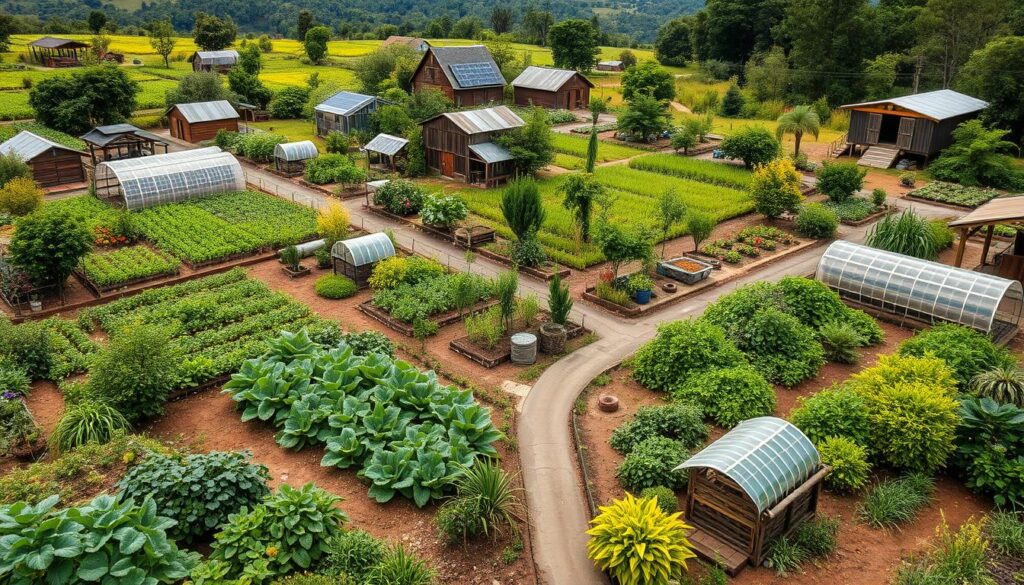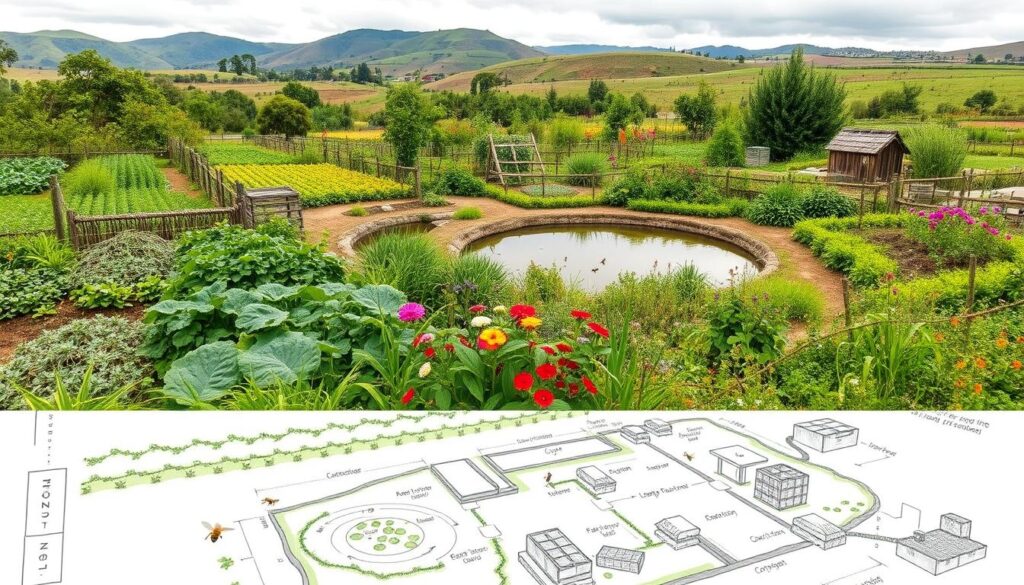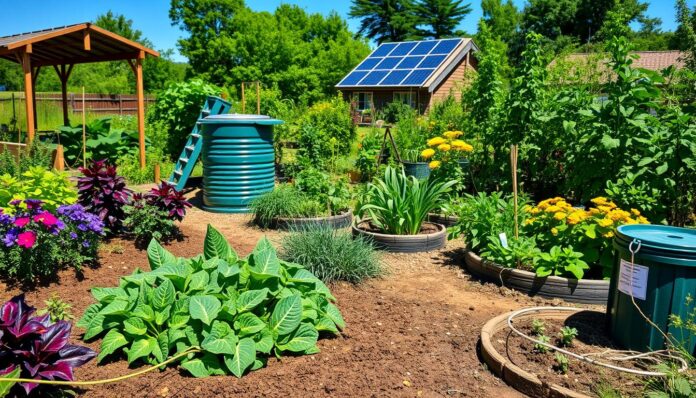In the last 20 years, Transition Economics has grown. It focuses on local food, energy, goods, and services. This has made permaculture’s financial side more interesting.
The Transition Town Movement started in 2005 and has grown worldwide. Financial Permaculture began in 2008. It shows how important it is to mix permaculture with finance for a sustainable future.
This mix is key for permaculture projects to last long. It helps them care for the environment and society. Plus, it makes sure the farmer can earn enough to live well.
Financial Permaculture aims for a balance. It wants to use the least time, money, and energy to get the most out of it. This is about getting the best “total economic return.”
This way of thinking is vital for permaculture’s financial health. It helps cut costs and boost income. This leads to a sustainable financial future for permaculture projects.
By using this method, permaculture projects can stay financially strong. They help create a better, more regenerative economy.
Key Takeaways
- Permaculture financial sustainability is crucial for the long-term viability of permaculture projects.
- Integrating permaculture with financial systems is essential for achieving sustainable finance in permaculture.
- Reducing costs and increasing revenue through innovative planning and diversification is key to permaculture financial sustainability.
- The average return in Financial Permaculture is determined by integrating the least input of time, money, and energy to achieve maximum productivity.
- Permaculture systems require innovative planning to integrate diverse agricultural practices while ensuring business viability within current economic structures.
- Achieving permaculture financial sustainability enables permaculture projects to take care of the environment and society while generating enough income to support the farmer’s lifestyle.
Introduction to Permaculture Financial Sustainability
Permaculture is a way to make environments productive and sustainable. It combines land, water, people, plants, animals, and technology. To be financially resilient in permaculture, understanding its principles is key. These principles help in managing finances effectively.
Financial sustainability is vital in permaculture. It helps projects last long and reach their goals. This is done by using local resources, reducing external inputs, and promoting biodiversity.
Understanding Permaculture Principles
Permaculture’s principles, like caring for the earth and each other, apply to finances too. They help in making smart financial decisions. This way, permaculture projects can build strong financial systems.
The Importance of Financial Sustainability
Financial sustainability is crucial for permaculture projects. It makes them last long and positively impact the environment and communities. Sustainable financial practices, like using less energy and growing local food, help achieve this.
Economic Models in Permaculture
Permaculture investing means using sustainable financial practices to create a better system. It focuses on caring for the environment, ensuring fairness, and promoting social equity. By getting community support and exploring funding options, permaculture projects can grow and help everyone financially.
Some key economic models in permaculture include:
- Community-supported agriculture (CSA) programs, which provide essential funding for permaculture initiatives
- Crowdfunding, which allows individuals to invest in permaculture projects and support their growth
- Microfinance, which offers small-scale permaculture projects access to capital and promotes financial inclusion
These economic models help permaculture projects become more sustainable and regenerative. They focus on both the environment and people’s well-being. This way, permaculture investing and sustainable financial practices can help create a fair and thriving ecosystem.

As the permaculture movement grows, finding new economic models is key. These models should support sustainability and regenerative practices. This will help build a stronger and fairer food system, encouraging permaculture investing and sustainable financial practices.
| Economic Model | Description |
|---|---|
| Community-supported agriculture (CSA) programs | Provide essential funding for permaculture initiatives |
| Crowdfunding | Allows individuals to invest in permaculture projects and support their growth |
| Microfinance | Offers small-scale permaculture projects access to capital and promotes financial inclusion |
Revenue Streams for Permaculture
Permaculture projects can make money in many ways. They sell products, host workshops, and create value-added items. This helps keep the project financially stable and promotes permaculture wealth management. It’s about building a system that gives back in many ways, not just one.
Creating value-added products is a big part of permaculture financial planning. This means turning farm products into things like jams, honey, or herbal remedies. This way, permaculture projects can meet the growing demand for organic and natural products, which people are willing to pay more for.
To learn more about starting a permaculture project, check out permaculturepractice.com. There, you can find out how permaculture can help you create a better food system. It’s a way to make money and be financially stable while doing good for the planet.
- Product sales: selling fresh produce, value-added products, or other goods directly to consumers
- Educational workshops and courses: teaching others about permaculture principles and practices
- Value-added products: processing and packaging farm products to increase their value
By looking into these ways to make money and using permaculture financial planning strategies, you can build a successful permaculture project. It will not only make money but also help make our food system better.
Cost Management in Permaculture
Managing costs well is key to success in permaculture. By using permaculture financial strategies, people can cut down on expenses. This is done by using natural resources like compost and manure for fertilizing crops instead of buying external inputs.
Another important part is sustainable finance in permaculture. This means using local resources like rainwater and solar power to save money. By doing this, people can lessen their environmental impact. For more on permaculture money, check out permaculture money to see why sustainable finance in permaculture matters.
Reducing Inputs through Natural Systems
Permaculture focuses on using natural systems to cut down on external inputs. This helps in reducing costs. Some ways to do this include:
- Using compost and manure to fertilize crops
- Implementing crop rotation and intercropping to reduce pest and disease pressure
- Using natural pest control methods, such as introducing beneficial insects
Utilizing Local Resources Effectively
Using local resources wisely is also crucial in permaculture. This means using resources like rainwater and solar power to save money. Some ways to do this include:
- Harvesting rainwater for irrigation and other uses
- Using solar power to generate electricity
- Implementing energy-efficient systems to reduce energy consumption
By using these strategies, people can lower their costs and make more money. This also helps in promoting sustainable finance in permaculture. Good cost management is vital for permaculture projects to succeed. By using natural systems and local resources, people can make their business more sustainable and profitable.
| Strategy | Benefits |
|---|---|
| Reducing inputs through natural systems | Minimizes external inputs, reduces costs, and promotes sustainability |
| Utilizing local resources effectively | Reduces reliance on external resources, decreases costs, and increases efficiency |
The Role of Grant Funding
Grant funding is key for permaculture projects. It helps them financially and supports sustainable practices. This funding lets projects reduce their environmental impact and promote eco-friendly farming.
Many organizations give grants for permaculture projects. The Small Planet Fund, RSF Social Finance Seed Fund, and Root Capital are some examples. Grants can be a few thousand dollars or even millions, depending on the project’s size and impact.
To get grants, projects need to show they understand permaculture. They must explain how their work will help the environment and the economy.

Identifying Suitable Grants
To find the right grants, projects should look for organizations that match their goals. This includes government agencies, non-profits, and private foundations. The Food and Farm Communications Fund (FFCF) and the AgroEcology Fund are good places to start.
Writing Successful Grant Proposals
Writing a good grant proposal is important. It should clearly explain the project, its goals, and how it will help the environment. It’s also crucial to understand what the grant provider wants. This way, projects can get the funding they need to be more sustainable.
| Grant Provider | Grant Amount | Focus Area |
|---|---|---|
| Small Planet Fund | $1,000 – $10,000 | Permaculture, sustainable agriculture |
| RSF Social Finance Seed Fund | $500 – $5,000 | Food and agriculture, permaculture |
| Root Capital | $100,000 – $1,000,000 | Sustainable agriculture, permaculture |
Creating a Business Plan for Permaculture
Creating a detailed business plan is key for permaculture projects. It outlines how to achieve financial stability. This plan should cover market analysis, marketing strategies, and how the project will run. By using sustainable financial practices in permaculture, projects can last long.
A good business plan also looks at permaculture investing chances. This includes community-supported agriculture and local partnerships. These can bring in steady money and help projects grow.
To make a solid business plan, permaculture projects need to do a deep market analysis. They should look at trends, who their customers are, and who they’re up against. This helps shape their marketing and sales plans, making sure they stay financially strong.
Some important parts of a permaculture business plan are:
- Market analysis and finding the right market
- Marketing plans and sales forecasts
- How the project will run and be managed
- Financial plans and budgeting
By adding these parts and thinking about permaculture investing chances, projects can make a detailed plan. This plan ensures they stay financially stable and succeed.
Collaborations and Partnerships
Permaculture projects do well when they work together. This means teaming up with local businesses to share resources and know-how. Building a strong network helps projects stay strong and sustainable. Good permaculture wealth management and permaculture financial planning are key. They help projects use resources wisely and make smart money choices.
Collaborations in permaculture also open doors to impact investing. This means investing in projects that make money and help society and the environment. Working with impact investors can bring in funds and know-how to help projects grow. Some big pluses of working together in permaculture include:
- More resources available
- Sharing knowledge and skills
- Projects become more resilient and sustainable
- Access to more funding and investment chances
As permaculture projects grow, the need for teamwork will grow too. Working closely with local businesses and impact investors opens up new chances for growth. This helps create a more sustainable and regenerative world. 
By working together on permaculture financial planning and permaculture wealth management, projects can face the future better. This might mean finding new ways to fund projects, building strong partnerships, and using tech to work smarter. The success of permaculture projects depends on building strong relationships and managing resources well.
Customer Engagement and Marketing
Effective customer engagement and marketing are key for permaculture success. Building a strong brand and using social media can help reach more people. This way, permaculture can share its sustainable finance practices.
Permaculture financial strategies aim to create a self-sustaining system. This benefits the environment and the community. By using these strategies, permaculture projects can be financially stable for the long term. They also help make the future more environmentally friendly.
Building a Brand in Permaculture
To build a brand in permaculture, you need to know your audience well. You also need to understand what makes your project special. A strong brand identity helps permaculture projects stand out. It attracts people who share their vision.
Social Media Strategies for Outreach
Social media is a great tool for permaculture projects to grow. It helps them share their sustainable finance practices with more people. By using social media, projects can connect with their community and build a loyal following.
Effective social media strategies include making engaging content and using the right hashtags. Working with influencers in sustainable living is also helpful. These actions can boost a project’s online presence and attract new supporters.
- Utilize social media platforms to share knowledge and experiences
- Collaborate with influencers in the sustainable living niche
- Create engaging content that resonates with the target audience
By using these strategies, permaculture projects can grow their online presence. They can engage with their community and promote their sustainable finance practices.
Diversification and Resilience
Permaculture projects gain from diversification and resilience. These are key for financial stability in permaculture. By growing many crops and products, projects don’t rely on just one market. This makes them more adaptable and resilient.
These strategies help permaculture projects stay strong financially. They also support ecological diversity and complexity. This is vital for facing uncertainty.
- Incorporating multiple crops and products to reduce dependence on a single market
- Adapting to market changes by being flexible and responsive to new opportunities and challenges
- Building resilience in permaculture systems by promoting ecological diversity and complexity
By using these methods, permaculture projects can improve their financial health. They also help the environment by supporting diversity and complexity. This is crucial for facing the unknown.

| Strategy | Benefits |
|---|---|
| Diversification | Reduces dependence on a single market, enhances ecological resilience |
| Adaptation to market changes | Allows projects to respond to new opportunities and challenges, builds resilience |
| Promoting ecological diversity and complexity | Enhances ecological resilience, promotes permaculture economic sustainability |
Measuring Success in Financial Sustainability
It’s key to measure success in financial sustainability for permaculture projects. This lets them see how they’re doing and make smart choices. Sustainable financial practices in permaculture mean watching things like how much money they make, how much they spend, and if they’re making a profit. By keeping an eye on these, permaculture projects can spot where they need to get better and tweak their money plans.
Investing in permaculture is all about looking ahead, and checking in on success over time is vital. Regular checks on the finances help permaculture projects stay on course and tweak their plans as needed. Important things to watch include:
- Revenue growth: Is the project making more money over time?
- Expense management: Are they spending wisely, and can they cut costs?
- Return on investment: Is the project making a profit, and can they make more?
By keeping tabs on these and using sustainable financial practices in permaculture, permaculture projects can keep their finances strong for the long haul.
| Metric | Target | Actual |
|---|---|---|
| Revenue growth | 10% | 12% |
| Expense management | 80% | 85% |
| Return on investment | 5% | 7% |
Challenges to Financial Sustainability
Permaculture projects often struggle with money issues, like not enough funds and market ups and downs. To tackle these problems, it’s key to plan for financial success. This means finding different ways to make money, building a strong support group, and making a financial system that can handle changes.
Some common mistakes in permaculture projects include bad financial planning, not diversifying, and not engaging with the community enough. To steer clear of these mistakes, permaculture projects should focus on financial planning. This involves making a detailed financial plan that fits the project’s unique needs and goals.

By using smart permaculture wealth management and financial planning, projects can beat financial challenges and last a long time. This can mean having many ways to make money, investing in local areas, and building a strong financial base. With the right financial planning, permaculture projects can grow and help the environment and local communities.
Some key strategies for overcoming financial hurdles in permaculture projects include:
- Diversifying revenue streams through multiple products and services
- Building a strong support network of community members and investors
- Creating a comprehensive financial plan that takes into account the unique needs and goals of the project
- Investing in local economies and building a resilient financial system
Innovative Funding Solutions
Permaculture projects often struggle to find traditional funding. Crowdfunding is a great solution. It lets people give small amounts to help a project. Many permaculture projects have used it to fund their work.
Subscription models and community-supported agriculture (CSA) programs are also good. They let people buy farm shares regularly. This helps farmers get a steady income and promotes sustainable farming.
These funding solutions have many benefits. They include:
- More funding for permaculture projects
- Less need for traditional funding
- More community support
- More sustainable and resilient projects
Using permaculture financial strategies helps grow sustainable agriculture. As more people want sustainable food, the market for it is growing fast. It’s expected to hit $1 trillion by 2030.
| Funding Solution | Benefits | Challenges |
|---|---|---|
| Crowdfunding | More funding, community support | Competition, fees |
| Subscription Models and CSA | Steady income, community support | Logistical issues, educating consumers |
Case Studies of Successful Permaculture Projects
Permaculture projects can become financially stable by using sustainable methods and finding different ways to make money. The Bangalore Model Farm is a great example. It shows how to use space well and increase profits.
The Urban Permaculture Project uses creative vertical gardening in small urban areas. This boosts productivity. The Agroforestry Success project shows how adding trees to farms can improve biodiversity and soil health. This leads to more money from timber, fruits, and crops.
These examples show how crucial financial stability is in permaculture. Projects can do well by using sustainable methods and finding various income sources. By following these examples, permaculture projects can grow and succeed over time.
The table below shows the financial success of a permaculture market garden:
| Year | Revenue | Costs | Net Profit |
|---|---|---|---|
| Year One | $2,000 | $2,000 (excluding labor) | Break-even |
| Year Two | $19,500 | $15,600 (labor) | $3,400 |
| Year Three | $42,000 | $37,800 | $4,200 |
| Year Five | $72,000 | $40,000 | $32,000 |
By studying these examples and their financial results, permaculture projects can learn how to be financially stable and sustainable.
Legal and Regulatory Considerations
When you invest in permaculture, you must understand the legal and regulatory rules. This includes knowing about zoning laws, permits, and taxes. It’s important to plan carefully and follow local laws for sustainable financial practices.
To follow the rules, you need to get the right permits and follow zoning laws. This might seem hard, but it’s key for your project’s success. Also, knowing about taxes can help you make better financial choices.
Navigating Zoning Laws and Permits
Zoning laws and permits change a lot based on where your permaculture project is. It’s crucial to know the specific rules in your area to avoid problems. Some important things to think about include:
- Getting the right permits for land use and building
- Following zoning laws and rules
- Understanding taxes and how to save money
Understanding Tax Implications
Taxes can greatly affect your permaculture project’s finances. It’s important to know the tax laws in your area and plan your finances wisely. This might mean using tax breaks for green practices and lowering your tax bill.
By understanding the legal and regulatory rules, permaculture investors can make their projects successful. This means knowing about zoning laws, permits, and taxes, and planning your finances for a sustainable future.
| Regulatory Consideration | Importance | Impact on Permaculture Investing |
|---|---|---|
| Zoning Laws and Permits | High | Ensures compliance and avoids potential issues |
| Tax Implications | Medium | Optimizes financial strategies and minimizes tax liabilities |
| Sustainable Financial Practices | High | Ensures long-term financial sustainability of permaculture projects |
Future Trends in Permaculture Financing
The world is moving towards more sustainable ways, and permaculture financing is changing too. Permaculture wealth management is now a big part of this shift. People and groups want to match their money goals with their values. Green finance is a big trend, with investors looking for ways to make money and help the planet.
Emergence of Green Finance
Green finance is key in backing permaculture projects, focusing on environmental care. This trend will keep growing, with more investors wanting to support green causes. Permaculture financial planning is vital for those wanting to benefit from this trend. It involves understanding the links between money, society, and nature.
The Role of Technology in Funding
Technology is also crucial in permaculture financing, creating new ways to fund projects. It connects investors with permaculture efforts, making it easier to support green projects. As permaculture grows, technology will likely play an even bigger role in its financing.
Conclusion
Exploring the financial side of permaculture shows us it’s not just about money. It’s about creating systems that are good for the planet and help communities grow. By using permaculture financial strategies and sustainable finance in permaculture, we can build strong, lasting systems.
Encouraging Community Involvement
At the core of permaculture success is the community’s active role. When everyone feels they own and care for the land, permaculture can truly change lives. By working together, teaching each other, and exploring new economic ways, we can help people play a big part in sustainable farming.

